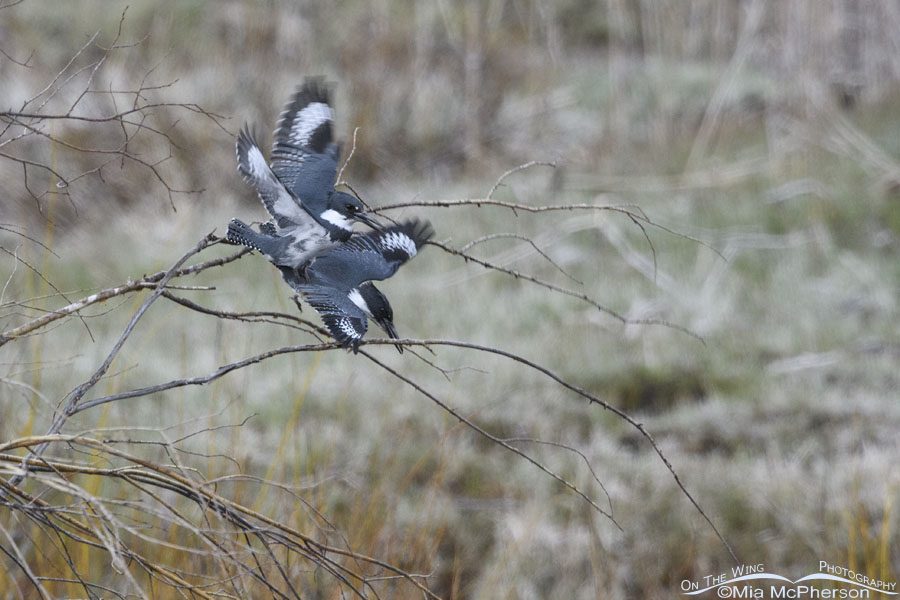I have been missing springtime in the mountains. There is so much snow up there from this past winter that most of the mountain roads I use are still closed. Those roads might be closed for a long time yet.
 Belted Kingfishers after mating in the mountains
Belted Kingfishers after mating in the mountains
There is still about 90% of the snowpack from this winter yet to melt. Areas where spring growth started last year by now are still snowbound. Last year, I was already photographing nesting Song Sparrows, hummingbirds nectaring on Wax Currants, and Glacier Lilies in bloom. I can’t even get to those locations right now.
Belted Kingfishers should already be digging their nesting burrows, and I wonder if they can do that when the ground is still frozen solid. The mating Belted Kingfishers in the image above were photographed on April 22, 2020, in the Wasatch Mountains, so I know they should be in nesting mode. The image is crappy, it won’t make it to my galleries, but it “said” what I wanted it to say for this post today.
I should already be seeing butterflies on wildflowers in the mountains and Uinta Ground Squirrels above the ground. A few weeks ago, I drove up into the mountains, and where I saw Uinta Ground Squirrels last year, I saw several feet of snow still on the ground. No squirrels.
I’ve been wondering where the migrant songbirds will nest if the conditions in the mountains are unsuitable and unstable for their nesting needs.
We needed all the snow, and it will be a temporary reprieve for the Great Salt Lake’s demise. I do have to wonder, though, how still having so much snow in the mountains will affect the birds and wildlife that live their lives up there.
The effects of nature aren’t always predictable. I should know; I am as much a part of nature as the birds I admire so much. Utah’s mountains are calling to me; it is my nature to listen and go.
Life is good.
Mia
Click here to see more of my Belted Kingfisher photos plus facts and information about this species.


Love the Kingfisher shot. Thanks Mia.
BTW: Concerning your bountiful snowfall in Utah, it was a great winter for Calif., as well. Tremendous, record breaking, snowfall from the southern Sierra’s to the Cascades. Lots of lakes and reservoirs are being replenished. However, every blessing has its bane and the spring runoff is going to create a lot of flooding problems in the valley’s. But after 20 years of below-average rainfall and 3 consecutive years of apocalyptic drought…we can’t complain. I hope next winter is as generous.
I do hope that you can scratch that itch. And soon. And that the birds/animals/plants are coping….
Great image!
It will be interesting to see if there’s a big melt, as apparently California is going to get– or is just now experiencing. Here’s hoping the snowmelt refurbishes the Great Salt Lake, aquifers, and that overflow is channeled to somewhere it can be stored for upcoming years. It does seem as if planning for channeling excess water needs to be done, and implemented.
We could all take a lesson from how pre-Inca civilization managed rapid excess water for times of drought
https://www.newscientist.com/article/dn27311-pre-inca-canals-may-solve-limas-water-crisis/
Seems they captured it and routed it (yes!) to locations where it would store until needed in dry season.
Hi Mia, Such a long winter. We live at 7000′ in Emigration Canyon. There is still so much snow to melt! When we had a few warm days a couple of weeks ago, a few robins and an intrepid broadtail showed up. Weather that followed sent them back down. I notices the robins showed up again yesterday. Should stick this time. Our feeders have seen heavy traffic from chickadees, juncos and nuthatch, as well as an army of jays, and quite a few downies. Anyhow, thanks for the water, bring on the spring. We are exhausted.
Warm regards,
Mark
No birds, no butterflies, no animals to speak of in the mountains but with the snowpack still in place does that mean you won’t have such a dry summer? I sure hope so.